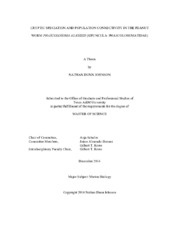Cryptic Speciation and Population Connectivity in the Peanut Worm Phascolosoma agassizii (Sipuncula: Phascolosomatidae)
Abstract
The prevalence of undetected cryptic species in marine environments is one of the greatest obstacles to obtaining an accurate estimate of biodiversity. Morphological identification can underestimate true levels of diversity, as it does not allow for the detection of cryptic species. Sipunculans, commonly called peanut worms, are thought to contain high levels of cryptic diversity due to their conserved morphology and their paucity of taxonomically informative characters. In this thesis, we use genetic-identification techniques to examine diversity within the Pacific sipunculan Phascolosoma agassizii. Mitochondrial DNA sequence data shows that P. agassizii is comprised of two cryptic species, one isolated to the eastern Pacific and one to the western Pacific. These clades exhibit large amounts of genetic divergence and are not recovered as sister taxa, suggesting an early speciation event within the Phascolosoma genus. Based on the location of the original holotype, the eastern Pacific clade represents the true P. agassizii, whereas the western Pacific clade is an undescribed species of Phascolosoma.
The long-lived stage within Phascolosoma agassizzi, known as a pelagosphera larva, is thought to engage in long-distance planktonic dispersal. Using a genetic technique called ISSR-PCR; we amplified non-coding polymorphic regions of the nuclear genomes of western and eastern P. agassizzii to test for levels of population connectivity along a coastline. Our ISSR results gave evidence for three to five genetically distinct populations within the western Pacific and two genetically distinct populations within the eastern Pacific. This data suggest that these coastal regions consist of genetically structured populations restricting intraspecies gene flow. Since the prevailing currents in these regions should connect most populations, larval behavior resulting in local recruitment may be the mechanism behind such population structure.
This research suggests that P. agassizii is not a single cohesive species, and in fact is comprised of two divergent clades. Each clade is isolated to a separate Pacific coast, with multiple genetically-distinct populations along each coast. This research highlights the need for combining genetic identification methods with morphological identification, especially in sipunculan taxonomy.
Citation
Johnson, Nathan Dunn (2014). Cryptic Speciation and Population Connectivity in the Peanut Worm Phascolosoma agassizii (Sipuncula: Phascolosomatidae). Master's thesis, Texas A & M University. Available electronically from https : / /hdl .handle .net /1969 .1 /153821.


